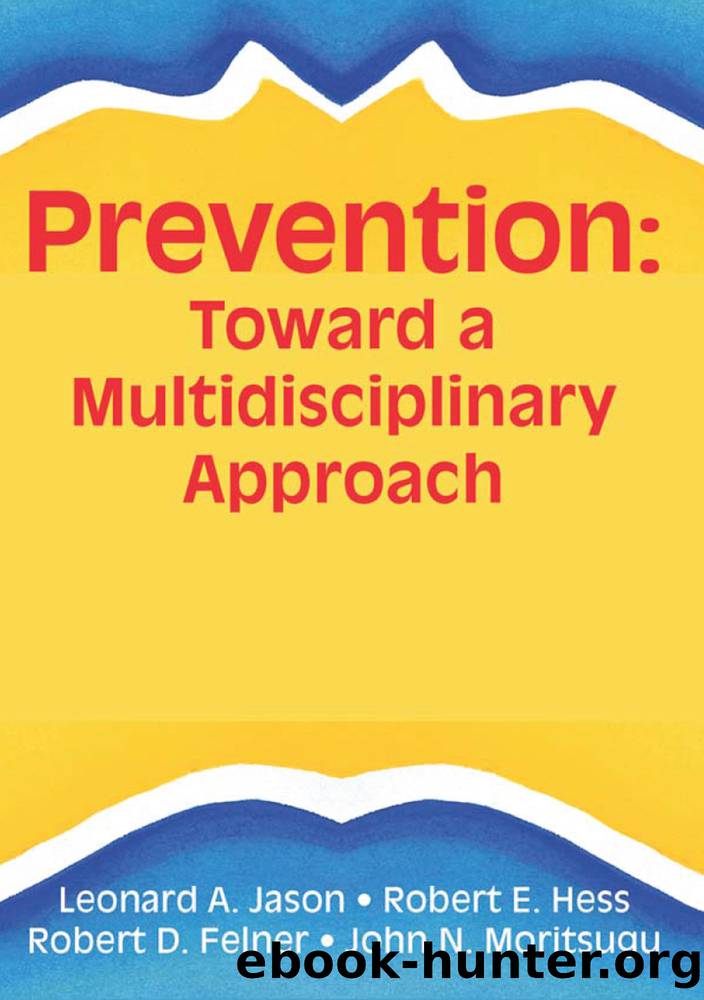The Ecology of Prevention by unknow

Author:unknow
Language: eng
Format: epub
Publisher: Taylor & Francis Group
Published: 2013-08-15T00:00:00+00:00
Working Within the System
It must be noted that a shortcoming of most of the proposed strategies in this chapter is that they require the development of new programming (but see above, Sprafkin & Rubenstein), a costly endeavor, and a fight for access, a difficult fight, indeed. A martial arts metaphor quickly informs us that we cannot overcome superior force with force, but must work in the direction of that force. Some examples of working with current network fare and affiliates illustrate this principle.
Shows with high ratings, e.g., currently âCagney and Laceyâ and âMiami Vice,â have huge audiences. The depiction of the dilemmas of abortion on âCagney and Laceyâ may well have had significant impacts on that audience. Such risky efforts could be supported by letter writing campaigns to the network instigated by preventive interventionists in concert with various organizations.
An incredible public health opportunity was lost when the leading character, Sonny Crockett, on âMiami Viceâ stopped smoking, but his cessation efforts and methods were not depicted on the program. Since part of the character's persona involved chainsmoking, showing how he stopped smoking, and hopefully, got over a relapse, could have been quite instructive and motivational.
These two examples indicate that with some redirection and external pressures and, hopefully, reinforcement, at least some current TV fare has considerable but largely untapped health promotion potential. The âMiami Viceâ and âCagney and Laceyâ examples also indicate that health behavior change strategies and controversial health matters can be woven into a story line or become the central story of an episode or even series of episodes. These two programs, as well as a recent made-for-TV movie on a family's attempts to deal with AIDS, also illustrate commercial TV's ability to use virtually every effective element in Table 1, and format in Table 2 (positive behavior modeled and reinforced, negative behavior modeled but punished), while retaining dramatic appeal and reaching huge audiences. Such possibilities may also be magnified if a star (e.g., Bill Cosby) who has production control over a series becomes particularly interested in health promotion or other issues and can present information and strategies repeatedly within the program series.
Interventionists can attempt to exploit these seemingly âwin-winâ situations. For example, we can gather what is currently known about health behaviors and change strategies and have ideas on how these key points can be presented using effective elements and formats with potential program scenarios. The next step would require active collaboration with affiliate and/or network personnel.
Jason et al. (in press) have recently shown the viability of this approach. They worked with a local affiliate and community groups in Chicago on a smoking cessation media-based series. Apparently, the affiliate also benefitted from increased audience ratings and improved public relations. The Jason et al. project was able to involve over 40 worksites in this collaborative effort.
It would be incorrect to interpret this last section as suggesting that we drop our efforts at access and regulatory change. Commercial TV will not be radically transformed overnight, nor is it likely to ever reach the full potential suggested by this last section.
Download
This site does not store any files on its server. We only index and link to content provided by other sites. Please contact the content providers to delete copyright contents if any and email us, we'll remove relevant links or contents immediately.
Chaco's Northern Prodigies : Salmon, Aztec, and the Ascendancy of the Middle San Juan Region after AD 1100 by Paul F. Reed(355)
Law Enforcement Interpersonal Communication and Conflict Management by Brian Douglas Fitch(347)
Digital International Relations by Unknown(344)
Critical Perspectives on Human Security : Rethinking Emancipation and Power in International Relations by David Chandler; Nik Hynek(329)
Skilled interpersonal communication: Research, theory and practice, Fifth edition by Owen Hargie(326)
The Enduring Color Line in U.S. Athletics by Krystal Beamon Chris M. Messer(323)
Evidence-Based Policy Making in Labor Economics by Hamermesh Daniel S.;Nottmeyer Olga K.;Nottmeyer Olga;King Sarah;King Sarah;King Sarah;(297)
EPSO CAST Political affairs EU policies: How to succeed in the selection procedure by Franco Reverte José María(290)
Writing Public Policy - A Practical Guide to Communicating in the Policy Making Process by Catherine F. Smith(272)
Criminological Theory in Context by John Martyn Chamberlain(269)
Tibeton Yoga Its Secret Doc by Evans-Wentz(266)
Threshold Concepts in Women's and Gender Studies by Christie Launius Holly Hassel(263)
Rothschild and Early Jewish Colonization in Palestine (Geographical Perspectives on the Human Past) by Ran Aaronsohn(263)
Positive Psychology and Spirituality in Counselling and Psychotherapy (Conflict, Ethics, and Spirituality, 12) by unknow(261)
Social Problems, Social Issues, Social Science by James Wright(259)
Play in child development and psychotherapy: toward empirically supported practice by Sandra W. Russ(252)
Cognitive Development in Infancy and Childhood (Elements in Child Development) by Mary Gauvain(252)
Latin American Politics and Society by Gerardo L. Munck & Juan Pablo Luna(222)
What Makes a Social Crisis?: The Societalization of Social Problems by Jeffrey C. Alexander(220)
